The opening round of the group stage of the UEFA Champions League offered many surprising results. Some of the teams demonstrated maturity and growth, while others left many questions unanswered with poor performances.
Napoli were one of the positive surprises this week, showing confidence and strong tactical preparation to secure a 4-1 win over Jürgen Klopp’s struggling Liverpool. The Merseyside club didn’t have the dreamt start of the Premier League season, earning only nine points from six games. They were hoping to have a fresh start in the CL to boost their confidence and give them the needed push in the league as well. However, it all ended up in a disappointing European football night.
Luciano Spalletti demonstrated great tactical intelligence against one of the most aggressive teams in possession, while his players not only executed his game plan well as a collective but surprised with individual skill as well.
Some of the new additions to the team proved that they have adjusted quickly, while Liverpool’s players looked exhausted and lacked creativity against the motivated Napoli team.
In this tactical analysis, we examine how Napoli managed to tame their opponents and what went wrong in Klopp’s tactics to get this disappointing result.
Lineups and individual impact
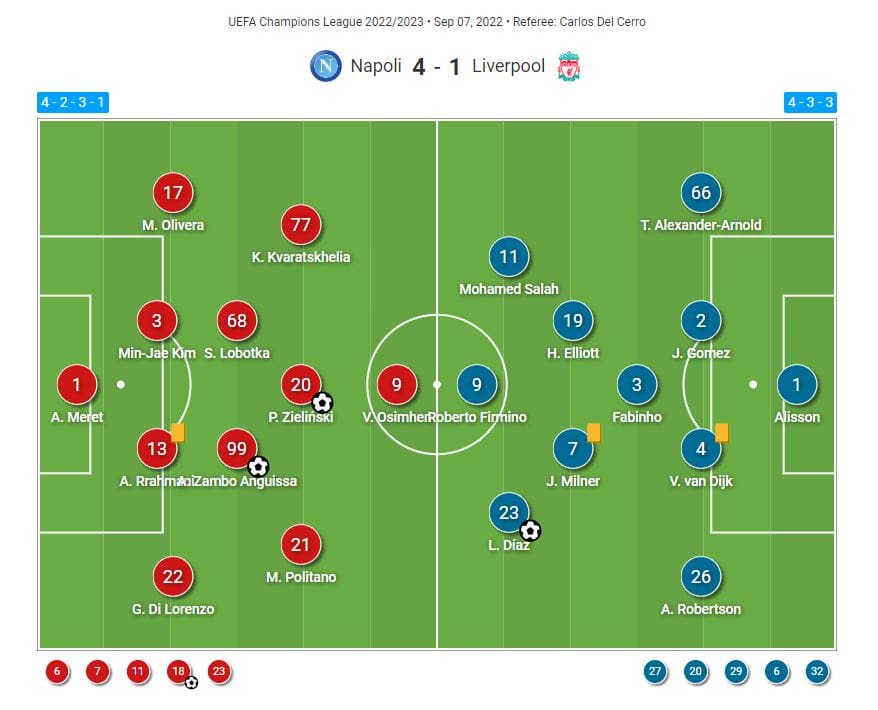
Alex Meret started on the goal and had a crucial role for Napoli conceding only once, making six saves and having a huge impact with his involvements. Mathías Olivera played on the left, while Giovanni Di Lorenzo covered the right full-back spot.
The central duo were key to the team’s positive result. The new addition Min-Jae Kim, who has been one of their best performers since the start of the season, impacted the game both in and out of possession and his partnership with Amir Rrahmani kept the box well-covered and made it difficult for Liverpool’s attackers to make positional interchanges and exploit quality areas.
Stanislav Lobotka played next to André Zambo Anguissa in midfield. Zambo Anguissa’s presence in the central areas provided additional defensive stability as he was highly active in his direct challenges and looked to intercept the ball frequently as well. His actions made it difficult for the Merseyside club to have any midfield impact. He finished the game with 14 ball recoveries, more than any player on the pitch. His contribution in possession was crucial as well as he would often initiate forward movement and use his passing to release pressure.
Khvicha Kvaratskhelia, Piotr Zieliński and Matteo Politano all supported Victor Osimhen in attack. The new left winger Kvaratskhelia has impressed since his arrival and troubled Liverpool’s defence with his progressive runs and movement to the box. He was a constant threat and Trent Alexander-Arnold and Joe Gomez struggled to split their responsibilities and cover him properly. He was also a main passing outlet for his teammates.
For Liverpool, Alisson covered the goal with a defensive line of Andrew Robertson, Virgil van Dijk, Gomez and Alexander-Arnold in front of him. The whole defence struggled to position defensively in a timely manner and were often outrun by their opponents. They were particularly inefficient in their direct challenges and often left empty spaces due to their high positioning.
James Milner, Fabinho and Harvey Elliot performed poorly in midfield and often failed to create a connection between the lines. They failed both in covering and in bypassing Zambo Anguissa which underlined their inability to counteract skilful players.
Luis Díaz, Roberto Firminho and Mohamed Salah were responsible to threaten the goal, however, Napoli’s deep positioning turned out troublesome for them to bypass. Many of the chances they created came from set-pieces opportunities but the increased awareness from Napoli’s defenders kept them away from scoring.
Liverpool’s inefficient midfield caused a lot of stress
Liverpool’s defensive struggles were noticeable from the beginning and started with their inability to counteract Napoli’s actions in midfield. While Liverpool were the high pressing team and had a highly positioned defensive line, Napoli rarely looked like the pinned-back side, thanks to their midfield dominance, and particularly Zambo Anguissa’s presence.
The Merseyside midfielders had difficulties in breaking through their opponents’ second line of defence. Although they spent most of the minutes in the opposition half, Gli Azzurri’s strategy of covering the central areas tightly and pushing Liverpool out was successful. It forced the Liverpool midfielders to often switch play and pass the ball laterally, which affected their supply to the final third.
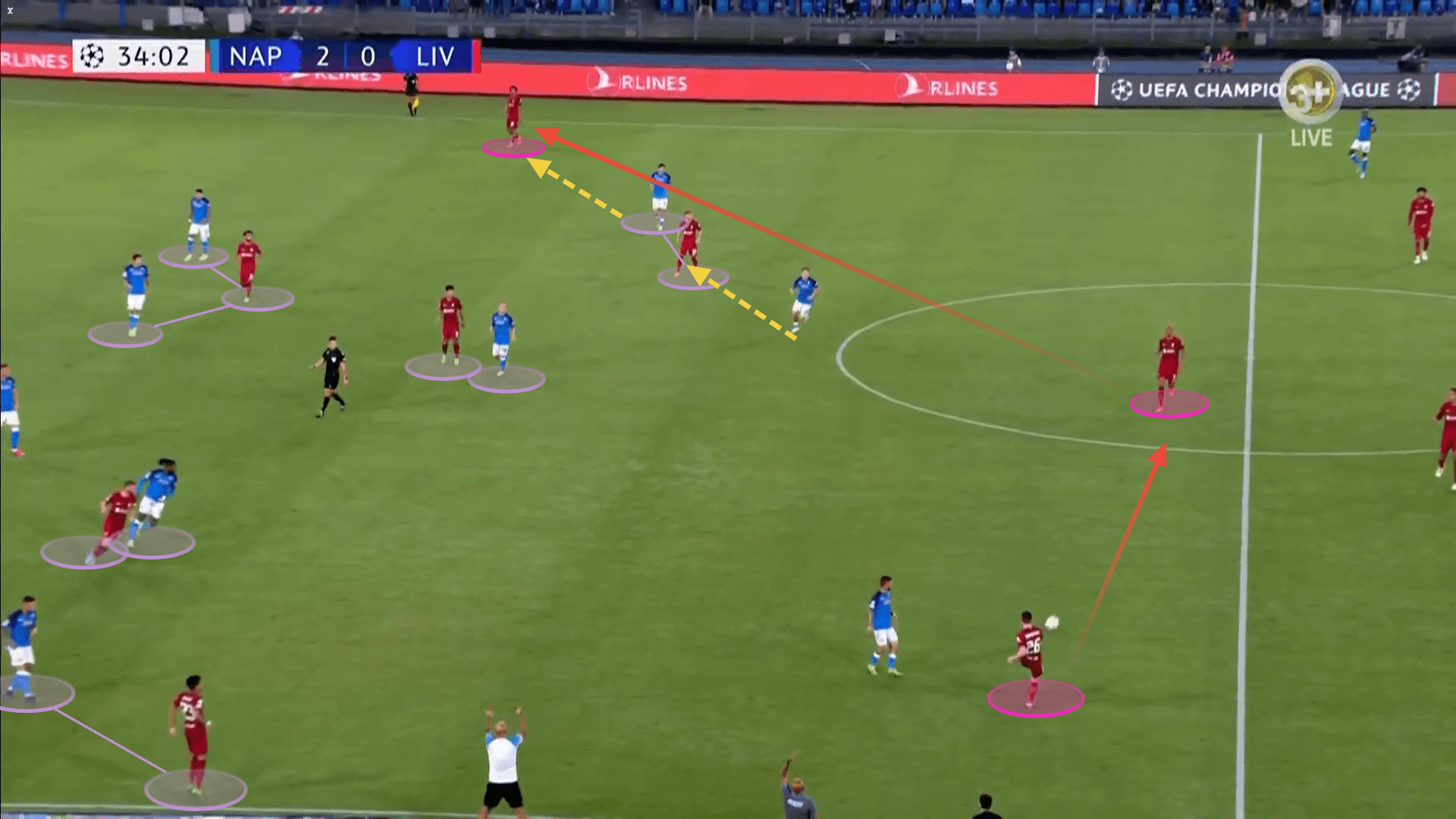
The lack of creative passing and the reliance on long balls allowed the opposition to anticipate many of Liverpool’s actions and recover the ball frequently. Elliot is the one who attempted to support the attacking actions but his inability to hold on to the ball prevented him from being efficient enough. He was the player who gave away possession most frequently, which gave the opposition more time on the ball.
That’s when their defensive struggles were revealed as well. Milner’s late actions often allowed Napoli to pass through rather easily. The lack of resistance in midfield put a lot of pressure on the team’s defensive line, which was often caught off-guard due to their high positioning. The defenders failed in splitting their responsibilities and showed poor work under pressure, which resulted in inaccurate actions.
The central pair had difficulties in covering Osimhen, Zieliński and Kvaratskhelia who would constantly aim to move centrally. Napoli’s players’ fluent movement and link-up-play and pace often dispositioned their opponents and their defensive line was left behind.
Liverpool lacked compactness, which is the reason why their usual pressing didn’t work. While the team were highly positioned, they lacked the aggressiveness off the ball, which resulted in leaving spaces Napoli weren’t hesitant to exploit.
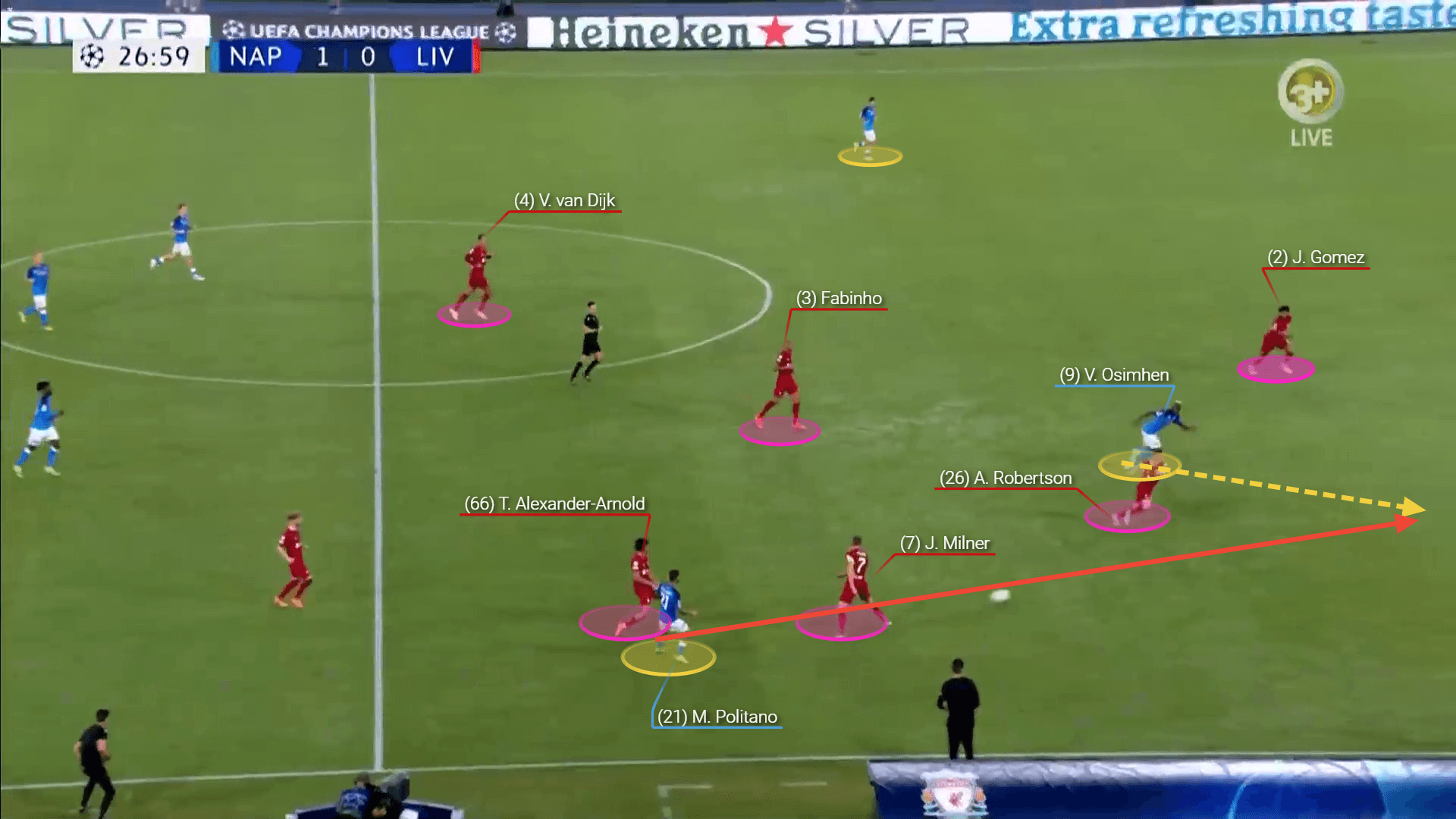
Thiago Alcântara was introduced in the 68th minute, which changed the whole dynamic of Liverpool’s midfield. His contribution both on and off the ball underlined his importance to the team. The player completed six tackles in 28 minutes, more than the whole defensive and midfield lines did prior to that.
Napoli’s successful offensive transitions
Spalletti’s side waited patiently to create chances. Despite their deep positioning, their movement off the ball combined with quick passing allowed them to take advantage of the opposition’s intense press. Gli Azzurri smartly invited pressure on multiple occasions, allowing some of their key men in attack to exploit spaces and receive once the team tried to recover the ball.
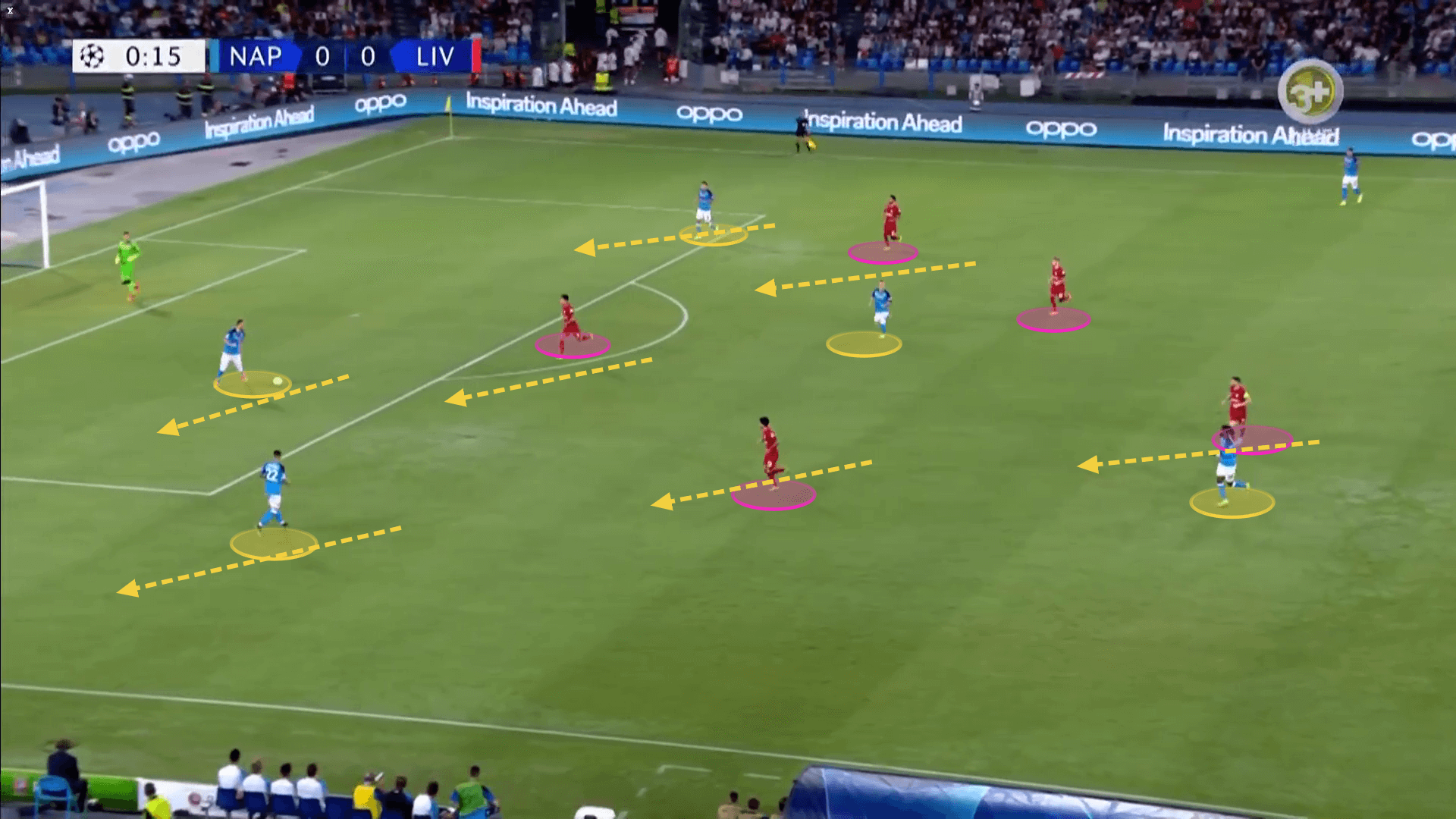
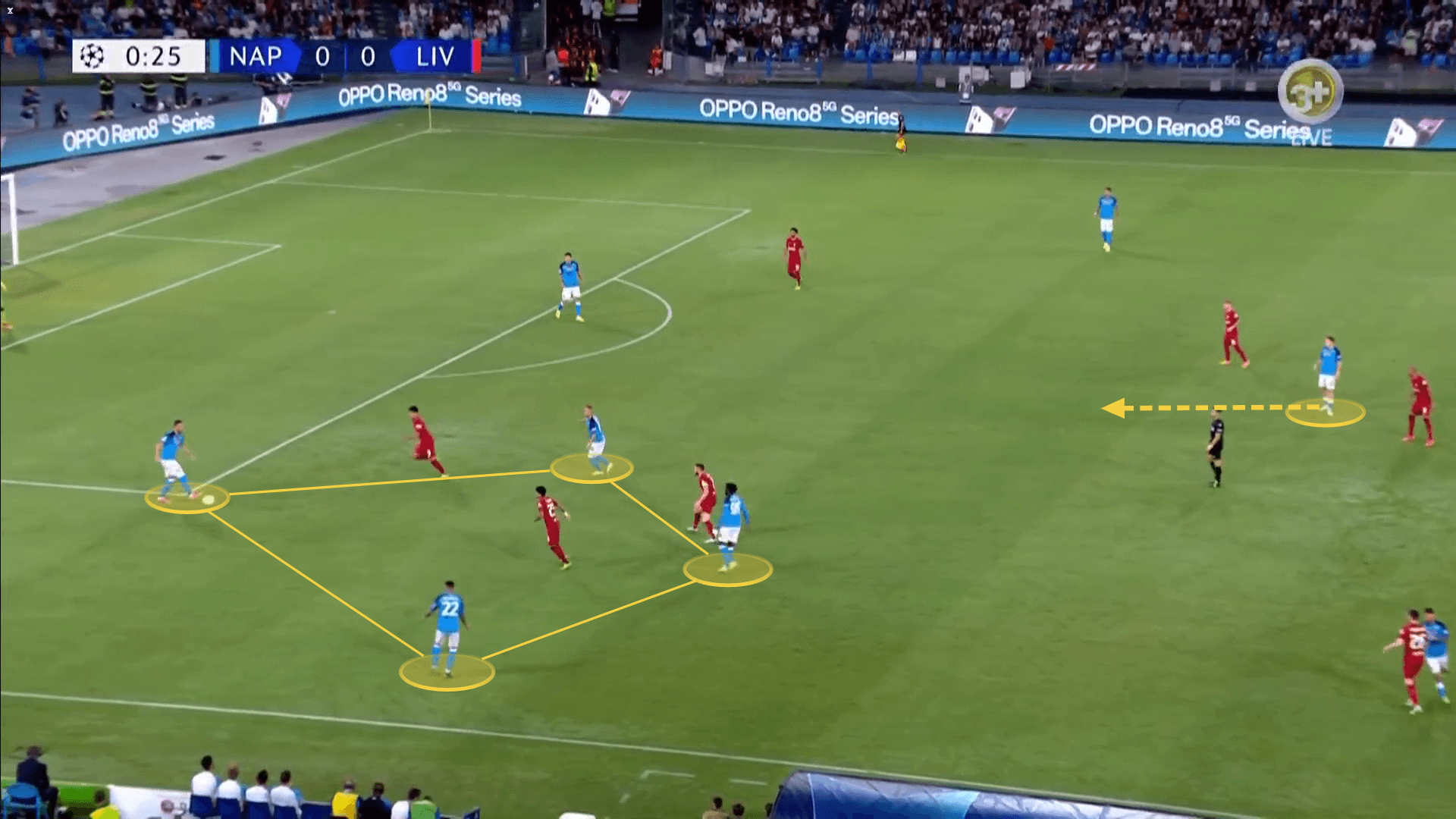
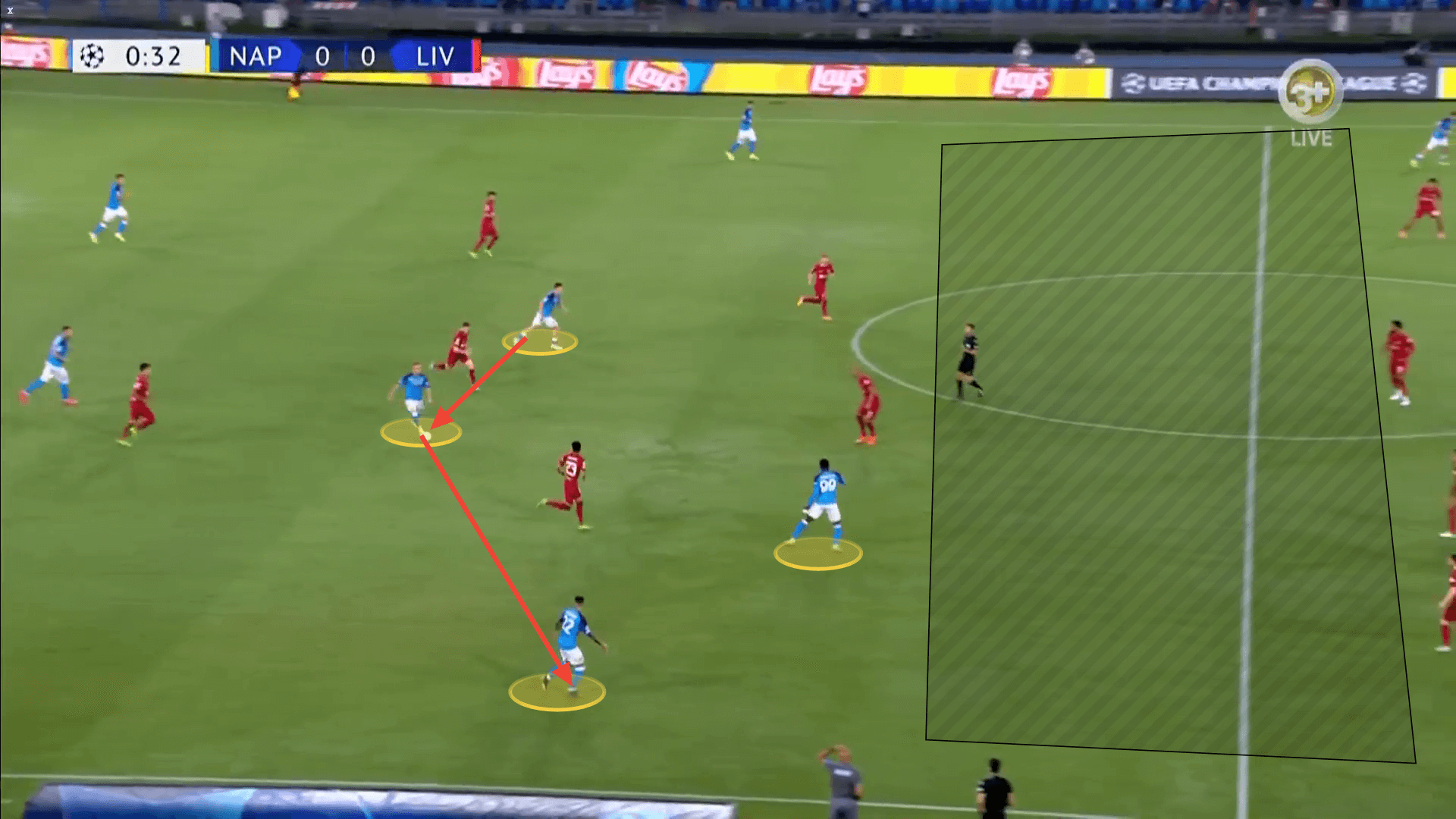
The team were very well prepared tactically. They knew how to take advantage of Liverpool’s aggressive high line. Their positioning allowed them to be quite effective on the counter, which resulted in 4/4 of their counterattacks ending with shots. This movement often came from Rrahmani’s high defensive awareness, where he would recover the ball and instantly move it forward so the team can expose Liverpool’s high positioning as a unit.
It was clear that Napoli had studied their opponents’ weak links, that’s why they relied mostly on attacking through the left side and exposing the spaces behind Alexander-Arnold where he had difficulties dropping in in a timely manner. The need for coverage in these areas would affect Gomez’s movement as well.
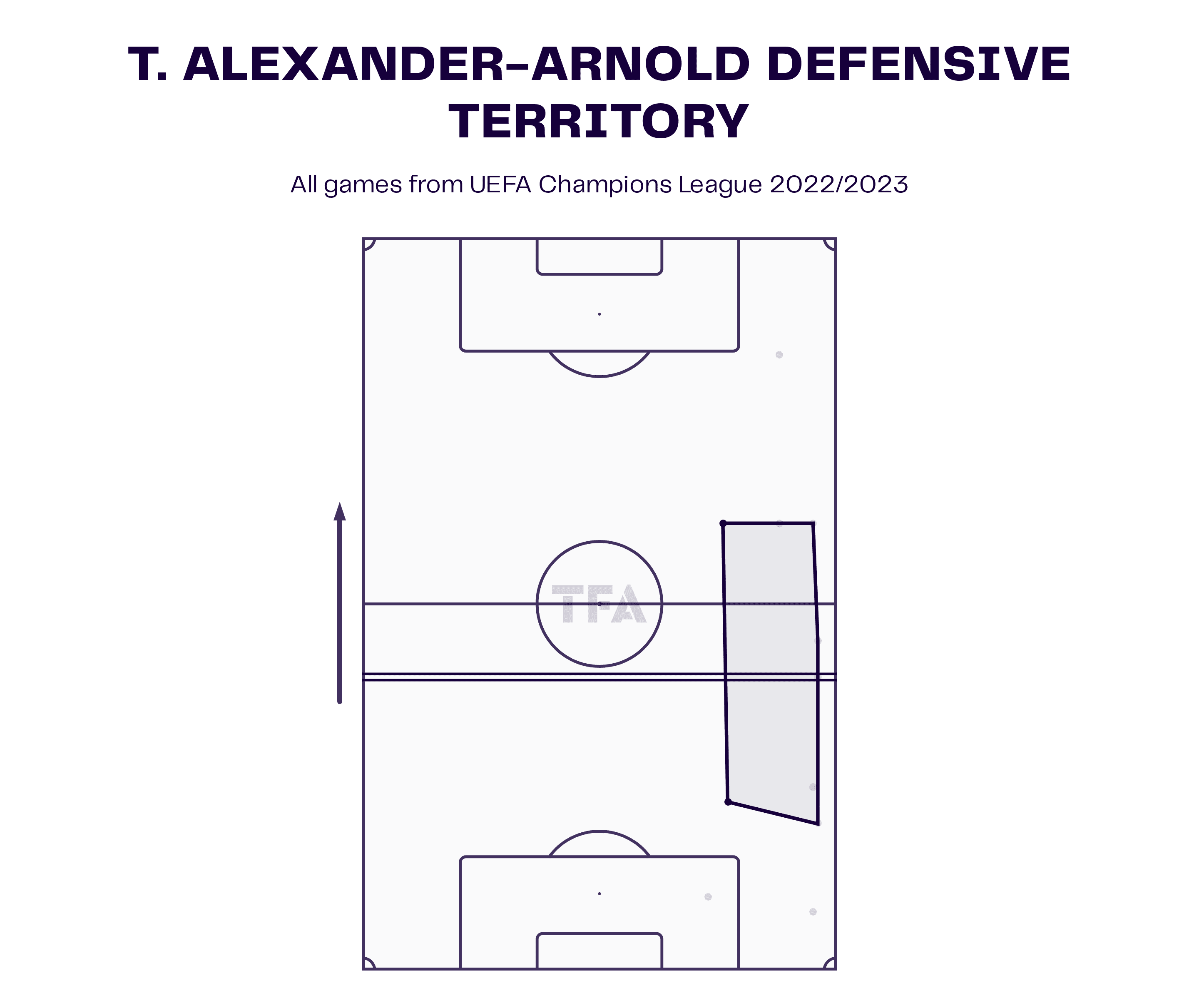
However, only a couple of the Italians’ attacks went through the right side as they preferred Di Lorenzo to stay focused defensively and not risk leaving any gaps behind. This was a successful strategy as he won 78% of his defensive duels and, for the most part, managed to counteract Díaz and Robertson. He would often move to the edge of the box, where he recovered the ball 10 times.
Despite having the fewest shots from the attackers, Osimhen’s impact was huge. He was the greatest distraction for the Liverpool players as they often overcommitted to covering him which gave his teammates space and time to coordinate. Politano failed to make an impact and was subbed in the 58th minute in favour of Hirving Lozano who increased the threat from the right as well as the pressure on the opposing defenders.
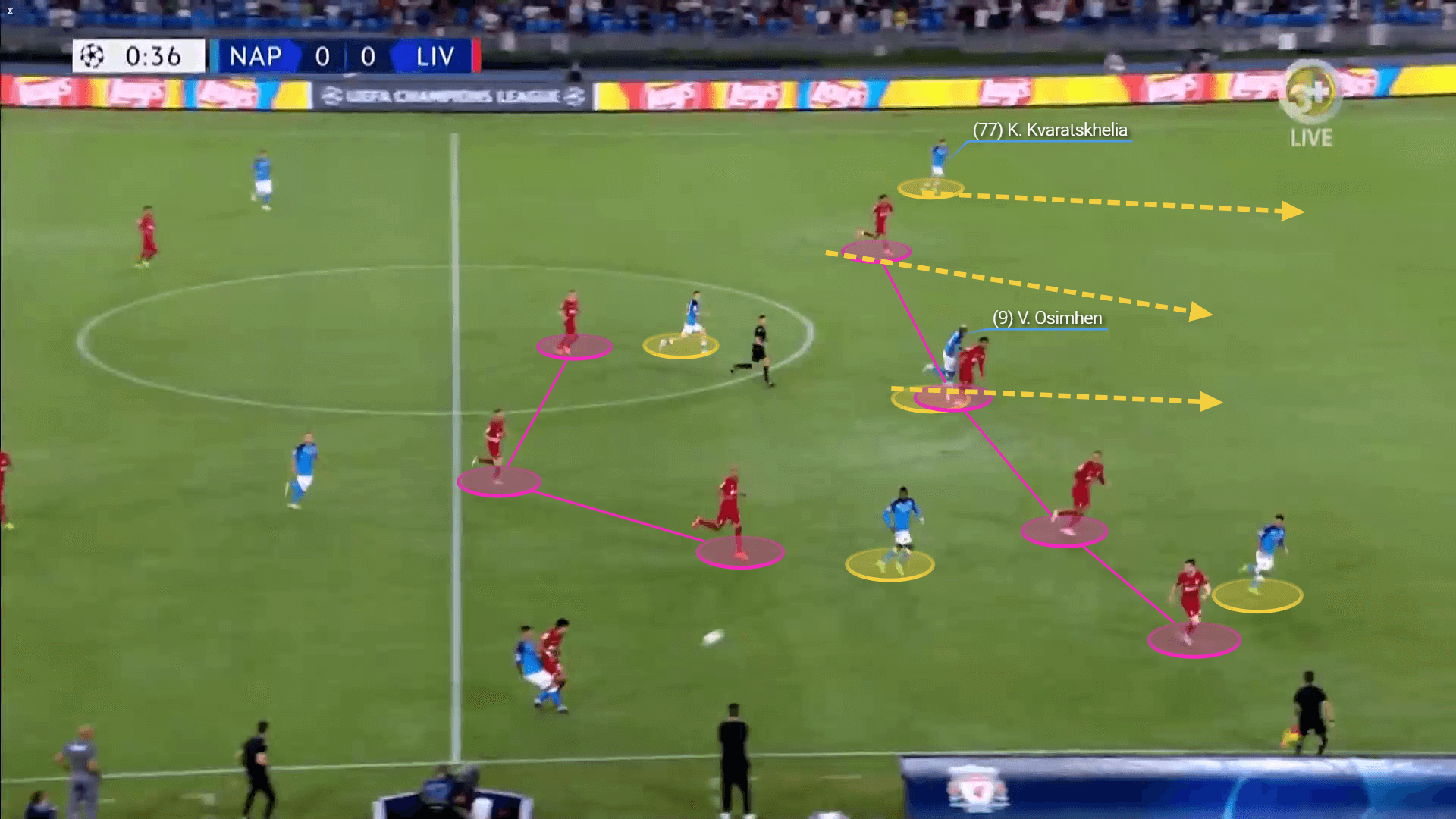
Merseyside’s struggles upfront
The combination of circumstances in Liverpool’s attack have resulted in them being a shadow of their previous selves. They still seem to be recovering from Sadio Mané’s departure and the injuries combined with Salah’s drop in form aren’t helping.
Klopp was forced to rely on Firmino, something he wouldn’t do too often in the previous seasons, and while the Brazilian undoubtedly has explosive moments, his overall impact and the threat he provides are not what Liverpool needed. He struggled to create chances against Napoli’s well-structured defence and his false 9 role made it difficult to connect with his fellow attackers.
Diogo Jota’s absence due to injury was also noticeable since the beginning of the season. His movement and explosiveness often result in creating chances in quality areas, something the team lacked against Napoli. While he was introduced in the second half, he failed to make an impact in front of the goal.
Lastly, but most importantly, Salah’s drop in form has immensely affected Liverpool’s efficiency in attack. Not only does he struggle to get into quality positions, but his accuracy has been lacking when he does have chances to score. This season, he has averaged 2.59 shots per 90 with a 31.6% accuracy, compared to 3.81 and 46.8% last season.
Conclusion
As our analysis showed, Spalleti had prepared his side well enough so they can expose Liverpool’s weaknesses while making it difficult for them to rely on their strengths. A strong connection between the lines and brilliant individual displays by some of the players resulted in the impressive 4-1 win.
On the other side, Klopp’s problems deepen as the team lacks concentration and have become too predictable. Getting some of his players back from injuries is a positive sign but the manager needs to find a way to adjust to the circumstances and balance out their performance in order to achieve better results.





Comments